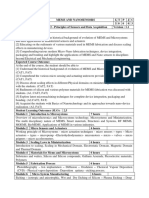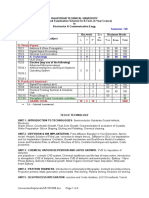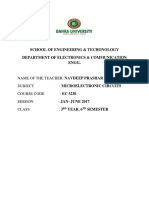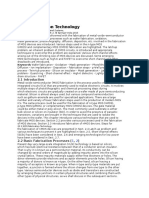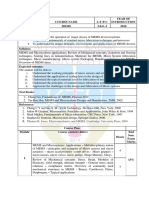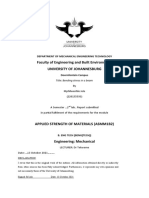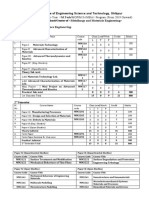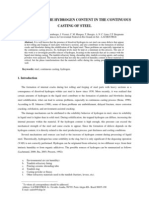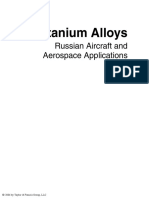MVLD507L - Ic-Technology - TH - 1.0 - 73 - MVLD507L - 67 Acp
MVLD507L - Ic-Technology - TH - 1.0 - 73 - MVLD507L - 67 Acp
Uploaded by
Mahesh N 22MVD0090Copyright:
Available Formats
MVLD507L - Ic-Technology - TH - 1.0 - 73 - MVLD507L - 67 Acp
MVLD507L - Ic-Technology - TH - 1.0 - 73 - MVLD507L - 67 Acp
Uploaded by
Mahesh N 22MVD0090Original Title
Copyright
Available Formats
Share this document
Did you find this document useful?
Is this content inappropriate?
Copyright:
Available Formats
MVLD507L - Ic-Technology - TH - 1.0 - 73 - MVLD507L - 67 Acp
MVLD507L - Ic-Technology - TH - 1.0 - 73 - MVLD507L - 67 Acp
Uploaded by
Mahesh N 22MVD0090Copyright:
Available Formats
Item 67/21 - Annexure - 25
Course Code Course Title L T P C
MVLD507L IC Technology 3 0 0 3
Pre-requisite NIL Syllabus version
1.0
Course Objectives
The course intended to
1. Introduce the process involved in semiconductor manufacturing, lithography and
fabrication.
2. Model the oxidation growth rate & to understand oxidation process and the process
of diffusion and to expound the Ion Implantation process.
3. Explain the thin film deposition process and review the difference between MOS and
Bipolar Process Integration.
Course Outcome
At the end of the course the student will be able to
1. Understand the process involved in semiconductor manufacturing, lithography and
fabrication.
2. Understand the various lithography techniques used for pattern transfer.
3. Apply models for understanding the oxidation growth.
4. Understand the diffusion mechanism in semiconductors.
5. Understand the process involved in thin film deposition.
6. Analyse the difference between MOS and Biploar Process
Module:1 Crystal Growth 5 hours
Introduction to Semiconductor Manufacturing and fabrication, Clean Room types and
Standards, Physics of the Crystal growth, wafer fabrication and basic properties of silicon
wafers.
Module:2 Lithography 7 hours
The Photolithographic Process, Photomask Fabrication, Comparison between positive and
negative photoresists, Exposure Systems, Characteristics of Exposure Systems, E-beam
Lithography, X- ray lithography
Module:3 Thermal Oxidation of Silicon 6 hours
The Oxidation Process, Modeling Oxidation, Masking Properties of Silicon Dioxide,
Technology of Oxidation, Si-SiO2 Interface
Module:4 Diffusion and Ion Implantation 7 hours
The Diffusion Process, Mathematical Model for Diffusion, Constant-, The Diffusion
Coefficient, Successive Diffusions, Diffusion Systems, Implantation Technology,
Mathematical Model for Ion Implantation, Selective Implantation, Channeling, Lattice
Damage and Annealing, Shallow Implantations.
Module:5 Thin film deposition, contacts, packaging 7 hours
and yield
Chemical Vapor Deposition, Physical Vapor Deposition, Epitaxy, Metal Interconnections and
Contact Technology, Silicides and Multilayer-Contact Technology, Copper Interconnects and
Damascene Processes, Wafer Thinning and Die Separation, Die Attachment, Wire Bonding,
Packages, Yield
Module:6 MOS Process Integration 5 hours
Basic MOS Device Considerations, MOS Transistor Layout and Design Rules,
Complementary MOS (CMOS) Technology
Module:7 Bipolar Process Integration 6 hours
Isolation Techniques in BJT fabrication, Advanced Bipolar Structures, Other Bipolar Isolation
Techniques. Deep Submicron Processes, Low-Voltage/Low-Power CMOS/BiCMOS
Processes. Future Trends and Directions of CMOS/BiCMOS Processes
Module:8 Contemporary Issues 2 hours
Proceedings of the 67th Academic Council (08.08.2022) 1355
Item 67/21 - Annexure - 25
Total Lecture hours: 45 hours
Text Book(s)
1. S.M. Sze, VLSI technology, 2017, Second Edition, Tata McGraw-Hill.
2. R.C. Jaeger, Introduction to microelectronic fabrication, 2013, Second Edition, Prentice
Hall.
Reference Books
1. S.A. Campbell, The science and engineering of microelectronics fabrication, 2012,
Second Edition, Oxford University Press, UK.
2. Simon M. Sze, Gary S. May, Fundamentals of Semiconductor Fabrication, 2011,Wiley.
Mode of Evaluation: Continuous Assessment Test, Digital Assignment, Quiz and Final
Assessment Test
Recommended by Board of Studies 28-07-2022
Approved by Academic Council No. 67 Date 08-08-2022
Proceedings of the 67th Academic Council (08.08.2022) 1356
You might also like
- Spring TestDocument5 pagesSpring Testmohanadymt50% (2)
- 1 Fabrication 20130218 PDFDocument108 pages1 Fabrication 20130218 PDFAjay kr PradhanNo ratings yet
- Equipment Inspection ChecklistDocument4 pagesEquipment Inspection ChecklistBharathi SilambarasanNo ratings yet
- VW 13750 English PDFDocument16 pagesVW 13750 English PDFOsvaldo MezaNo ratings yet
- Eee590 Ic-Technology SyllabusDocument2 pagesEee590 Ic-Technology SyllabusKeerthiKalyanNo ratings yet
- Fabrication Course OutlineDocument4 pagesFabrication Course OutlineOmarNo ratings yet
- Ece3038 Mems-And-nano-sensors TH 1.1 47 Ece3038Document2 pagesEce3038 Mems-And-nano-sensors TH 1.1 47 Ece3038Sai ViswanathNo ratings yet
- Bmee406e Advanced-Manufacturing-Processes Eth 1.0 70 Bmee406eDocument3 pagesBmee406e Advanced-Manufacturing-Processes Eth 1.0 70 Bmee406eSrinivasan NarayananNo ratings yet
- IC FabricationDocument78 pagesIC FabricationSayandip Kar0% (1)
- Silicon Photonics Design: From Devices To Systems: March 2015Document3 pagesSilicon Photonics Design: From Devices To Systems: March 2015Cristian VargasNo ratings yet
- Semester: VII: A. Theory PapersDocument4 pagesSemester: VII: A. Theory PapersAkhil KhandelwalNo ratings yet
- Micro Course FileDocument47 pagesMicro Course FileRatish DhimanNo ratings yet
- Course Title Course No(s) DE ZC415/MEL ZC415 Credit UnitsDocument15 pagesCourse Title Course No(s) DE ZC415/MEL ZC415 Credit UnitsUmesh BhadaleNo ratings yet
- Silicon Photonics Design: From Devices To Systems: March 2015Document3 pagesSilicon Photonics Design: From Devices To Systems: March 2015Fawaz LabeebNo ratings yet
- Course Name Ic Fabrication Course DescriptionDocument2 pagesCourse Name Ic Fabrication Course DescriptionJeff LaycoNo ratings yet
- B.Tech 7th Sem ECE FinalDocument17 pagesB.Tech 7th Sem ECE FinalInvincible 2.0No ratings yet
- De ZC415 Course HandoutDocument14 pagesDe ZC415 Course Handoutgofem10387No ratings yet
- 2022 Ch0-Course IntroductionDocument10 pages2022 Ch0-Course IntroductionSư LưuNo ratings yet
- Ece MT SylDocument79 pagesEce MT Sylpermiable permissionNo ratings yet
- Birla Institute of Technology & Science, Pilani Work Integrated Learning Programmes Digital Learning Part A: Content DesignDocument5 pagesBirla Institute of Technology & Science, Pilani Work Integrated Learning Programmes Digital Learning Part A: Content Designkansal611No ratings yet
- Icft Mel ZG611 Course HandoutDocument4 pagesIcft Mel ZG611 Course Handoutsaireddykakumanu97No ratings yet
- VLSI SyllabusDocument1 pageVLSI Syllabusbrijeshkumar30596No ratings yet
- Integrated Circuits and Semiconductor TechnologyDocument4 pagesIntegrated Circuits and Semiconductor TechnologyultrasonicdochNo ratings yet
- Mel ZG611Document5 pagesMel ZG611jitendraNo ratings yet
- Principles of MEMS TransducersDocument19 pagesPrinciples of MEMS TransducersTechdevtodo DevtodoNo ratings yet
- Material Science: Development TeamDocument12 pagesMaterial Science: Development TeamTejinder SinghNo ratings yet
- Vlsi Technology Lesson PlanDocument4 pagesVlsi Technology Lesson PlanMahendra BabuNo ratings yet
- GoPV-SummerSchool Session2 EPFL 2Document45 pagesGoPV-SummerSchool Session2 EPFL 2davidgarciavazquezNo ratings yet
- Chapter IIIDocument43 pagesChapter IIIJerry boyNo ratings yet
- IC Fabrication TechnologyDocument5 pagesIC Fabrication TechnologyEldo N BabyNo ratings yet
- Pulsed Laser Ablation and Micromachining of 4H and 6H SiC Wafers PDFDocument113 pagesPulsed Laser Ablation and Micromachining of 4H and 6H SiC Wafers PDFagiles6No ratings yet
- MsmeDocument3 pagesMsmeJigneshkumar PatelNo ratings yet
- ECE 374 TsybeskovDocument2 pagesECE 374 TsybeskovMeryam BakkarNo ratings yet
- Electrical & Electronic Engineering Program School of Engineering & Information Technology Universiti Malaysia SabahDocument4 pagesElectrical & Electronic Engineering Program School of Engineering & Information Technology Universiti Malaysia Sabahram010No ratings yet
- Layout Design, Fabrication and Characterization of N-Channel MOSFETDocument7 pagesLayout Design, Fabrication and Characterization of N-Channel MOSFETashiqur rahman rahulNo ratings yet
- MOS Fabrication Technology: Abstract This Chapter Is Concerned With The Fabrication of Metal-Oxide-SemiconductorDocument7 pagesMOS Fabrication Technology: Abstract This Chapter Is Concerned With The Fabrication of Metal-Oxide-SemiconductorsammyNo ratings yet
- ECS&KTUDocument2 pagesECS&KTUVishnu Prasad MNo ratings yet
- Compound Semiconductor Device ModellingDocument54 pagesCompound Semiconductor Device ModellingakashNo ratings yet
- Micro Electromechanical SystemDocument22 pagesMicro Electromechanical SystemLandi KhaibuNo ratings yet
- Wk1-Intro, Scaling TrendsDocument11 pagesWk1-Intro, Scaling TrendsAmin MoosaviNo ratings yet
- VLSI ModulesDocument28 pagesVLSI Modulessai_karthik89No ratings yet
- Course No. Course Title Teaching Schedule Allotment of Marks Duration of Exam (HRS.) L T P EL-303N Course Outcomes (CO) CO-1Document2 pagesCourse No. Course Title Teaching Schedule Allotment of Marks Duration of Exam (HRS.) L T P EL-303N Course Outcomes (CO) CO-1GauravNo ratings yet
- Bece201l Electronic-Materials-And-Devices TH 1.0 0 Bece201lDocument3 pagesBece201l Electronic-Materials-And-Devices TH 1.0 0 Bece201lkambojnaman2005No ratings yet
- DEE6113 Course Outline Jun2016Document4 pagesDEE6113 Course Outline Jun2016FonzBahariNo ratings yet
- VLSI Fabrication Process PDFDocument6 pagesVLSI Fabrication Process PDFMagotra 9301No ratings yet
- Course Contents of VLSIDocument2 pagesCourse Contents of VLSIOmer KhanNo ratings yet
- Ec465 MemsDocument2 pagesEc465 MemsAnupriya T MNo ratings yet
- Microfabrication of Electrochemical RevisedDocument26 pagesMicrofabrication of Electrochemical Revisedmikegloughran13No ratings yet
- Micromachines 14 01200 v3Document37 pagesMicromachines 14 01200 v3rudy.riera0409No ratings yet
- BOSE - Ic Fabrication Technology (Paperback) - MC GRAW HILL INDIA (2011)Document369 pagesBOSE - Ic Fabrication Technology (Paperback) - MC GRAW HILL INDIA (2011)GIRISH GIDAYENo ratings yet
- MSE123Document3 pagesMSE123Kun HoNo ratings yet
- Zhao 2018Document30 pagesZhao 2018ROBERTO KARLO CAMPOS TIRADONo ratings yet
- Engineering Physics - Course - Syllabus - 2023-24Document5 pagesEngineering Physics - Course - Syllabus - 2023-24ajshahapur9999No ratings yet
- MicroelectronicsDocument39 pagesMicroelectronicsArun Av0% (1)
- 4 (A) .Micro Electro Mechanical System (Elective)Document11 pages4 (A) .Micro Electro Mechanical System (Elective)RaviNo ratings yet
- PolyMUMPs ProcessDocument28 pagesPolyMUMPs ProcessMajid GhaffarNo ratings yet
- Mems and IcsDocument2 pagesMems and IcsSonal SoniNo ratings yet
- Biomedical Applications of MemsDocument12 pagesBiomedical Applications of MemsvpsampathNo ratings yet
- Updated-Optical Fibre m1 - AutosavedDocument176 pagesUpdated-Optical Fibre m1 - AutosavedMangala NageshwariNo ratings yet
- VLSI Spin-Offs and Technological Innovation: T.J. TateDocument5 pagesVLSI Spin-Offs and Technological Innovation: T.J. TatePRAVEEN1640No ratings yet
- Cheunq - Unknown - SySTEMS For HARshDocument193 pagesCheunq - Unknown - SySTEMS For HARsh'Aizat Hafiz'No ratings yet
- The Nano-Micro Interface: Bridging the Micro and Nano WorldsFrom EverandThe Nano-Micro Interface: Bridging the Micro and Nano WorldsNo ratings yet
- Module 5 CVD and PVD - 2Document24 pagesModule 5 CVD and PVD - 2Mahesh N 22MVD0090No ratings yet
- WINSEM2022-23 MVLD602L TH VL2022230505508 2023-04-05 Reference-Material-I PDFDocument2 pagesWINSEM2022-23 MVLD602L TH VL2022230505508 2023-04-05 Reference-Material-I PDFMahesh N 22MVD0090No ratings yet
- AXI BusDocument23 pagesAXI BusMahesh N 22MVD0090No ratings yet
- Verilog Hand Written NotesDocument42 pagesVerilog Hand Written NotesMahesh N 22MVD0090No ratings yet
- WINSEM2022-23 MVLD613L TH VL2022230505495 2023-04-24 Reference-Material-IIDocument46 pagesWINSEM2022-23 MVLD613L TH VL2022230505495 2023-04-24 Reference-Material-IIMahesh N 22MVD0090No ratings yet
- Neeharika Manne Muddu: Education StrengthsDocument1 pageNeeharika Manne Muddu: Education StrengthsMahesh N 22MVD0090No ratings yet
- DOC-20230508-WA0002. - (3 Files Merged)Document15 pagesDOC-20230508-WA0002. - (3 Files Merged)Mahesh N 22MVD0090No ratings yet
- 0.edge Detection - Sobel Algorithm (8 Files Merged)Document33 pages0.edge Detection - Sobel Algorithm (8 Files Merged)Mahesh N 22MVD0090No ratings yet
- Basics 3Document16 pagesBasics 3Mahesh N 22MVD0090No ratings yet
- Lect43 How To Create An InterfaceDocument15 pagesLect43 How To Create An InterfaceMahesh N 22MVD0090No ratings yet
- 10147-9 SampleDocument3 pages10147-9 SampleSun ShadeNo ratings yet
- Steel PipeDocument39 pagesSteel PipeJay PanalanginNo ratings yet
- Piping and Plumbing Fittings PDFDocument5 pagesPiping and Plumbing Fittings PDFmichol201450% (4)
- Accepted Manuscript Not Copyedited: Starting Poiseuille Flow in A Circular Tube With Two Immiscible FluidsDocument24 pagesAccepted Manuscript Not Copyedited: Starting Poiseuille Flow in A Circular Tube With Two Immiscible FluidsMoslem UddinNo ratings yet
- Case Studies in Structural Repair of Pretensioned Concrete ProductsDocument6 pagesCase Studies in Structural Repair of Pretensioned Concrete Productsmekkawi6650No ratings yet
- Simulation and Evaluation of Slurry ErosionDocument85 pagesSimulation and Evaluation of Slurry ErosionskyerfreeNo ratings yet
- Kişisel Bilgiler: Pakistan / Yüksek LISANS 2016924612 / 21PK006282Document6 pagesKişisel Bilgiler: Pakistan / Yüksek LISANS 2016924612 / 21PK006282hussainNo ratings yet
- Appendix: C C CD CDocument28 pagesAppendix: C C CD CNajeeb A.MNo ratings yet
- F1 Annual Examination (Chem) - 2Document9 pagesF1 Annual Examination (Chem) - 2IsraelNo ratings yet
- Applied Lab 2Document11 pagesApplied Lab 2MPHILWENHLE JELENo ratings yet
- How Non-Ionic Electrically Neutral'' Surfactants Enhance Electrical Conductivity and Ion Stability in Non-Polar LiquidsDocument7 pagesHow Non-Ionic Electrically Neutral'' Surfactants Enhance Electrical Conductivity and Ion Stability in Non-Polar LiquidsdsfsfNo ratings yet
- M.Tech (Metallurgy & Materials Engineering)Document3 pagesM.Tech (Metallurgy & Materials Engineering)Dharbaranyeswaran MNo ratings yet
- IV. Netting Materials For Fishing GearDocument6 pagesIV. Netting Materials For Fishing GearTine CajegasNo ratings yet
- The Copperbelt UniversityDocument46 pagesThe Copperbelt UniversityDICKSON SIMUTAMINo ratings yet
- BOQ - HVAC WorksDocument6 pagesBOQ - HVAC Workswali mustafaNo ratings yet
- Cold in Place RecyclingDocument10 pagesCold in Place RecyclingRajesh ChoudharyNo ratings yet
- Reduction of The Hydrogen Content in The Continuous Casting of SteelDocument7 pagesReduction of The Hydrogen Content in The Continuous Casting of SteelBrigida Pagani0% (1)
- General Chemistry Tutorial 3: Choose The Correct Answer For Questions 1-6Document4 pagesGeneral Chemistry Tutorial 3: Choose The Correct Answer For Questions 1-6Kedai KasutNo ratings yet
- Base Plate Hss2Document37 pagesBase Plate Hss2Sana UllahNo ratings yet
- Slabs ComputationDocument13 pagesSlabs ComputationGintokiNo ratings yet
- G-160 Tube Testing Tool: EST GroupDocument2 pagesG-160 Tube Testing Tool: EST GroupMaximiliano Ezequiel LopezNo ratings yet
- A Guide To Clean in Place (CIP)Document6 pagesA Guide To Clean in Place (CIP)Dominic TolentinoNo ratings yet
- 9 CorrosDocument25 pages9 CorrosFrancisco Beltran100% (1)
- Purlin and Wall Girt Design-Span 9mDocument16 pagesPurlin and Wall Girt Design-Span 9mNarasimha AkkammagariNo ratings yet
- Author - Titanium Alloys - Russian Aircraft and Aerospace ApplicationsDocument6 pagesAuthor - Titanium Alloys - Russian Aircraft and Aerospace ApplicationsMarcelo CarvalhoNo ratings yet
- MATERIAL SAFETY DATA SHEET (Finished Products Only) : Section One: IdentityDocument2 pagesMATERIAL SAFETY DATA SHEET (Finished Products Only) : Section One: IdentityClaudio Israel Godinez SomeraNo ratings yet
- Batch ListDocument6 pagesBatch ListAjay KumarNo ratings yet






